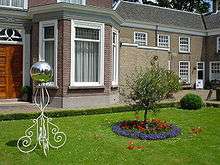Yard globe
A yard globe, also known as a garden globe, gazing ball, lawn ball, garden ball, gazing globe, mirror ball, chrome ball, or orb, is a mirrored sphere typically displayed atop a conical ceramic or wrought iron stand as a lawn ornament. Its size ranges from 2 to 22 inches in diameter, with the most popular gazing ball being about 12 inches (30 cm). Gazing balls were glass but can now be stainless steel, ceramic, or stained glass.
Unlike hanging friendship balls or witch balls that have a loop, gazing balls have a stem so they can securely sit in a stand. Larger sizes can be made but prove difficult due to the weight of the blown glass.

History
Gazing balls originated in 13th century Venice, Italy, where they were hand-blown by skilled craftsmen.
King Ludwig II of Bavaria, sometimes referred to as Mad King Ludwig, adorned his Herrenchiemsee palace with lawn balls. Thereafter, they became a fixture of European gardens and are associated with Victorian era English gardens in particular.
Gazing balls enjoyed a brief resurgence in popularity in the 1930s. They appear in a number of modernistic gardens of the period as a variation on the traditional sundial or birdbath centrepiece. Many of them from this period may have been made in polished metal rather than glass.
Their popularity was probably influenced by the illuminated glass globe which was the central focal point of the modernist garden shown at the Exposition Internationale des Arts Decoratifs et Industriels Modernes, Paris, in 1925. The "Jardin d’Eau et de Lumière" was triangular in shape, largely consisting of tiered triangular reflecting pools and planting beds. At the center of the ensemble was an electrically propelled and internally illuminated sphere of stained glass. "The mirror globe turning slowly to reflect lights is rather a night-club trick than a serious attempt at garden decoration. But it is completely successful in focusing the interest and relieving, by its unexpected location, what would otherwise be an altogether stiff pattern."
Other modernist garden designs followed, using plain metal or glass mirror globes; notable examples included several roof top gardens developed by Department Stores in London, America and Australia. This probably made the ispread the idea
The gazing ball suited the geometric clean lines of the Art-Deco style especially the visual connection with the chrome plating which was part of the Streamline-moderne aesthetic of the 1930s and 1940s - so much so in fact that they became identified in many people’s minds as an invention of the 1930s.
Subsequently many people in the 1950s and afterwards viewed them as a bit tacky; an example of prosaic suburban taste of the interwar period on a level with garden gnomes - they have never quite regained status.
